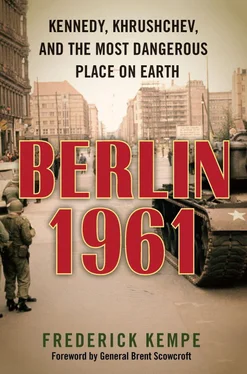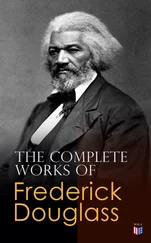“In the nature of things”: FRUS, 1961–1963, vol. XIV, Berlin Crisis, 1961–1962, Doc. 193, Telegram from the Department of State to the Mission at Berlin, Washington, October 26, 1961, 8:11 p.m.; Department of State, Central Files, 762.0221/10-2661.
E. Allan Lightner Jr.: Slusser, The Berlin Crisis of 1961 , 377–378; Smith, The Defense of Berlin , 319–320.
Lightner knew there was a slim chance: Bruce W. Menning, “The Berlin Crisis of 1961 from the Perspective of the Soviet General Staff,” in William W. Epley, ed., International Cold War Military Records and History . Proceedings of the International Conference on Cold War Military Records and History held in Washington, D.C., March 21–26, 1994, 10–13; Smyser, Kennedy and the Berlin Wall , 135; Gerhard Wettig, Chruschtschows Berlin-Krise 1958 bis 1963: Drohpolitik und Mauerbau . Munich and Berlin: R. Oldenbourg, 192.
Ulbricht had apparently approved: Cate, The Ides of August , 476; Slusser, The Berlin Crisis of 1961 , 353–358.
Encouraged by Clay: FRUS, 1961–1963, vol. XIV, Berlin Crisis, 1961–1962, Doc. 189, Telegram from the Mission at Berlin to the Department of State, Berlin, October 24, 1961, 1 p.m., drafted by Lightner.
Clay disagreed: FRUS, 1961–1963, vol. XIV, Berlin Crisis, 1961–1962, Doc. 181, Letter from the President’s Special Representative in Berlin (Clay) to President Kennedy, Berlin, October 18, 1961; Smith, Lucius D. Clay , 642–643; 651–654; JFKL, Lucius D. Clay OH , July 1, 1964.
Unlike Clay, Lightner: Cate, The Ides of August , 476; Smith, The Defense of Berlin , 319; Raymond L. Garthoff, Detente and Confrontation: American-Soviet Relations From Nixon to Reagan . Washington, D.C.: Brookings Institution Press, 1994; Smith, Lucius D. Clay , 659; HSTL, E. Allan Lightner OH , October 26, 1973.
Lightner told friends: Interview with Vern Pike, Washington, D.C., November 17, 2008; Gelb, The Berlin Wall , 250–253; HSTL, E. Allan Lightner OH , October 26, 1973.
As that night’s script: FRUS, 1961–1963, vol. XIV, Berlin Crisis, 1961–1962, Doc. 186, Telegram from the Mission at Berlin to the Department of State, Berlin, October 23, 1961, 2 p.m.; Cate, The Ides of August , 476–480.
“Look,” Lightner said to the policeman: Cate, The Ides of August , 477.
About then, four American tanks: “U.S. Protests to Soviet,” New York Times , 10/24/1961.
By the time Lightner’s VW: The Atlantic Times , October 2005: William R. Smyser, “Tanks at Checkpoint Charlie. In October 1961, the World Faced a War”: http://www.atlantic-times.com/archive_detail.php?recordID=319; Cate, The Ides of August , 479–480, 484.
Once East German radio: Cate, The Ides of August , 479–480; Howard Trivers, Three Crises in American Foreign Affairs and a Continuing Revolution , 41–44.
Back in Washington, Kennedy: Ashton, Kennedy, Macmillan and the Cold War , 62; Reeves, Kennedy: Profile of Power , 249; Norman Gelb, The Berlin Wall: Kennedy, Khrushchev, and a Showdown in the Heart of Europe. New York: Dorset Press, 1986, 253; Smyser, Kennedy and the Berlin Wall , 137.
National Security Advisor Bundy had warned: Ann Tusa, The Last Division: A History of Berlin, 1945–1989 . London: Hodder and Stoughton, 1997, 330; JFKL, NSF, Memo from Bundy to the President, August 28, 1961, Box 86, Berlin; Wyden, Wall , 264.
Though in his letter Clay: FRUS, 1961–1963, vol. XIV, Berlin Crisis, 1961–1962, Doc. 181, Letter from the President’s Special Representative in Berlin (Clay) to President Kennedy, Berlin, October 18, 1961; also in JFKL, NSF, Germany, Berlin, General Clay, Top Secret.
What followed was the general’s resignation: Smith, Lucius D. Clay , 662–663.
At a time when Kennedy badly wanted: Frédéric Bozo, Two Strategies for Europe: De Gaulle, the United States, and the Atlantic Alliance . Lanham, MD: Rowman & Littlefield, 2001, 70, 71; Ashton, Kennedy, Macmillan and the Cold War , 62.
De Gaulle had disapproved: Charles de Gaulle, Lettres, notes et carnets (1961–1963) . Paris: Plon, 1986, 155–158; William R. Smyser, “Zwischen Erleichterung und Konfrontation. Die Reaktionen der USA und der UdSSR auf den Mauerbau,” in Hans-Hermann Hertle, Konrad Hugo Jarausch, and Christoph Klessmann, eds., Mauerbau und Mauerfall: Ursachen—Verlauf—Auswirkungen . Berlin: Christoph Links, 2002, 147–158 (151).
As harsh as it was, de Gaulle’s letter: JFKL, POF, De Gaulle–Kennedy Letter Exchange, Box 116A.
Despite two months of U.S. diplomatic: FRUS, 1961–1963, vol. XIV, Berlin Crisis, 1961–1962, Doc. 176, Telegram 1025 from the Department of State to the Embassy in Germany, Washington, October 13, 1961; a similar letter was sent to de Gaulle: Telegram 2136 to Paris, October 13, 1961, in Department of State, Central Files, 762.00/10-1361.
With that as prelude: Cornelius Ryan, The Longest Day: June 6, 1944. New York: Simon & Schuster, 1994, 107.
De Gaulle told Gavin: FRUS, 1961–1963, vol. XIV, Berlin Crisis, 1961–1962, Doc. 187, Telegram from the Embassy in France to the Department of State, Paris, October 23, 1961.
Emboldened by the success: FRUS, 1961–1963, vol. XIV, Berlin Crisis, 1961–1962, Doc. 189, Telegram from the Mission at Berlin to the Department of State, Berlin, October 24, 1961, 1 p.m.
The White House staff considered: Gelb, The Berlin Wall , 127–128; Cate, The Ides of August , 101.
Given Ambassador Gavin’s failure: FRUS, 1961–1963, vol. XIV, Berlin Crisis, 1961–1962, Doc. 188, Memcon, Delivery of Letter to the President from Chancellor Adenauer, Washington, October 24, 1961; New York Times , 10/25/1961, 10/26/1961.
Grewe knew Adenauer: FRUS, 1961–1963, vol. XIV, Berlin Crisis, 1961–1962, Doc. 164; also see for Rusk–Gromyko meeting, Memcon, September 30, 1961, in Department of State, Central Files, 611.61/9-3061.
Speaking to Lightner, Kohler: FRUS, 1961–1963, vol. XIV, Berlin Crisis, 1961–1962, Doc. 190, Memo from the Assistant Secretary of State for European Affairs (Kohler) to Secretary of State Rusk, Washington, October 24, 1961, in Department of State, Central Files, 762.00/10-2461.
United States Army first lieutenant: Interview with Vern Pike, Washington, D.C., November 17, 2008. Also see his unpublished book Checkpoint Charlie’s Angels (written with Edward W. Plaisted).
A policeman blocking her path: Der Kurier , 10/28/1961, 10/29/1961.
U.S. commanders had placed: “U.S. Tanks Face Soviet’s at Berlin Crossing Point,” New York Times , 10/28/1961.
Even as the Soviets: Gelb, The Berlin Wall , 248; Smith, The Defense of Berlin , 324; FRUS, 1961–1963, vol. XIV, Berlin Crisis, 1961–1962, Doc. 193, Telegram from the Department of State to the Mission at Berlin, Washington, October 26, 1961, 8:11 p.m.
Clay had never been more convinced: Department of State, Central Files, 762.0221/10-2661: Telegram 835 (Clay to Rusk), October 26, 1961, 1 p.m., mentioned in FRUS, 1961–1963, vol. XIV, Berlin Crisis, 1961–1962, Doc. 193.
He outlined how: Department of State, Central Files, 762.0221/10-2561: Telegram 824 (Clay to Department of State), October 25, 1961, 12:34 p.m.; Secretary Ball discussing General Clay’s plan: ibid., Doc. 178: Memo from Acting Secretary of State Ball to President Kennedy, Action for Dealing with the Possible Closing of the Friedrichstrasse Entry Point into East Berlin, Washington, October 14, 1961; ibid., Doc. 180, Telegram from the Department of State to the Mission at Berlin, Washington, October 18, 1961; National Security Archive, Berlin, Norstad, dated 10/26/1961: Norstad to Clarke (CINCUSAREUR), 36.
Читать дальше











